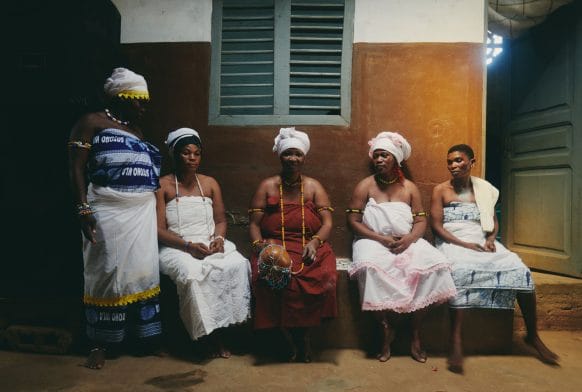
Gun-stock club of vesi wood with flattened head terminating in a curved ridge and a large thumb like spur. In the crotch between the two features there is a distinctive ridge, and the concave edge of the club has been distorted into several ridges. The shaft is of ovate section and terminates in a flattened domed pommel. The entire straight section of the shaft is wrapped in a coconut fibre cordage binding which alternated between a cord a of natural colour and one that has been dyed black. At the neck a strip of pandannas leaf has been looped twice around the club and tied off, and the same has been done at the butt with the addition of some green and yellow European wool.
Curved Club, Waka Kiakavo, Fiji, Western Polynesia This curved, two-handed club is termed a waka kiakavo, and it has several typical features of many Fijian club types: large, top-heavy and expanding at the head, forward-curved with a second spur branching off the outer curve of the head. The curved form focuses the club’s force into a small area of the head, while the spur and thickening of the head increase the mass generating that force. It was a Fijian practice to poetically name objects after their resemblance to different animals or plants, and a similarly-shaped but lighter style of club was known as gata or ‘snake’ for obvious reasons. The name waka for this type reflects its heaviness and the distinctively ridged inner curve under the head. These ridges are an interesting feature of this style, as they are not carved into the wood, but produced by distorting the living sapling during its growth. Curved clubs like this were carefully trained into their final shape several years in advance of their cutting, and the inner ridges of the waka were repeatedly beaten into the sapling over this period. The advantages of this method were two-fold: firstly, the finished club retained the natural structural strength of the living tree’s grain throughout; secondly, the overall amount of necessary woodworking was greatly reduced. Kiakavo, the second half of this style’s name, reflects the little ornamental ridge inside the fork of the head, which is a feature found on dance clubs used as props in Fijian men’s club-dances (meke). This is a fancy kind of waka, therefore, as is reflected by the addition of exotic imported yellow and green sheep’s wool to the traditional coconut-fibre wrapping (magimagi). Wood, coconut fibre, wool. Mid-19th Century. Provenance unknown.
fighting
































































































































































































































































































































































































































































































































